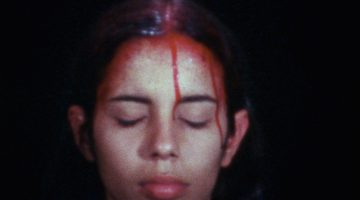In New York at the New Museum German artist Rosemarie Trockel is currently on view, and truly deserves a visit. The exhibition is “A Cosmos” which is considered a survey of her work from the past 40 years. Through the eyes of the artist, Trockel says her works are kindred spirits which is an accurate label due to her practice and methodology in the studio. Kindred is defined as “One’s family and relations; similar in kind; related.” It is known that Trockel has a gift for defining relationships with objects and images from different eras that all have similarities with one another creating dialogues between the elements of each piece or installation. These relationships come about organically as she curates the elements for each arrangement allowing a mental space for viewers to evaluate the cultural identities and significance to the components within the works. This can be observed with Trockel’s large terrarium works that have a polished display quality, and operate as a time capsule for the numerous objects of different origins contained behind crystal clear surfaces. What stand out most about her work is the inclusion of objects that are culled from scientific research from the realm of natural history bringing fact based artifacts to the world of art and conceptualized ideas. Other installations in “A Cosmos” are worth visiting like one involving basic white tiles that you would see in a bathroom setting, wall mounted sculpture, photography and an artificial palm tree helplessly hung upside down in the middle of the space (image below). Other works by Trockel are on view such as her more renowned wool pieces, and recent ceramic works.
-Contributed by Gregory Ito
Venue: New Museum, New York
Artist: Rosemarie Trockel
Exhibition Title: A Cosmos
Exhibition Dates: Closes January 20th, 2013
Website: http://www.newmuseum.org/exhibitions/view/rosemarie-trockel-a-cosmos
Press Release (Excerpt):
Although remarkably inventive and prolific, Trockel has deflected any identifiable stylistic signature: films and videos, knit paintings, projects for children, ceramics, drawings, and collages, plus a panoply of sculptures in a range of materials, are among the myriad forms that comprise her practice. Nonetheless, certain constants underpin this diverse activity: contending notions of feminism, purported antagonisms between the amateur and professional creator, the celebrity and the unknown maker, and between the fine, as opposed to the applied, arts and crafts. More broadly, Trockel probes interrelations between humans and animals, and our impact, as a species, on the natural world.
The epicenter of “Rosemarie Trockel: A Cosmos” is a small, tiled room devoted exclusively to the work of this mid-career German artist; reminiscent of a Wunderkammer, it mixes the fantastical, the erotic, and the perverse. The exhibition spaces that radiate from this nucleus throughout the Museum’s three floors have been installed typologically, as in a traditional natural history museum, or thematically, as in many museums of modern art. These very distinct installation strategies generate fundamentally different ways of viewing.
The Museum’s Second Floor presents a broad selection of Trockel’s work in conjunction with a selection of artifacts created by individuals not normally recognized as professional artists, whom she considers kindred spirits, nonetheless. Many come from the realm of natural history, and from zoology and botany, in particular. The drawings and models they created originally served as pedagogical tools for scientific research but today are appreciated primarily in aesthetic terms. In addition, there are a number of self-taught artists, including James Castle, Morton Bartlett, Judith Scott, and Manuel Montalvo, who worked in isolation or obscurity—the products of their fertile imaginations created with the humblest of materials and the most economic of means. Also present are works by two contemporary artists whose reputations have unjustifiably gone into eclipse, Günter Weseler and Ruth Francken, as well as an abstract expressionist triptych made by an orangutan, Tilda, appropriated and arranged by Trockel. Whether operating within the framework of a disciplinary field, like botany, or propelled by more autonomous internal directives, these highly diverse figures provide models of dedication to their chosen vocations that, for Trockel, are exemplary and inspiring.







